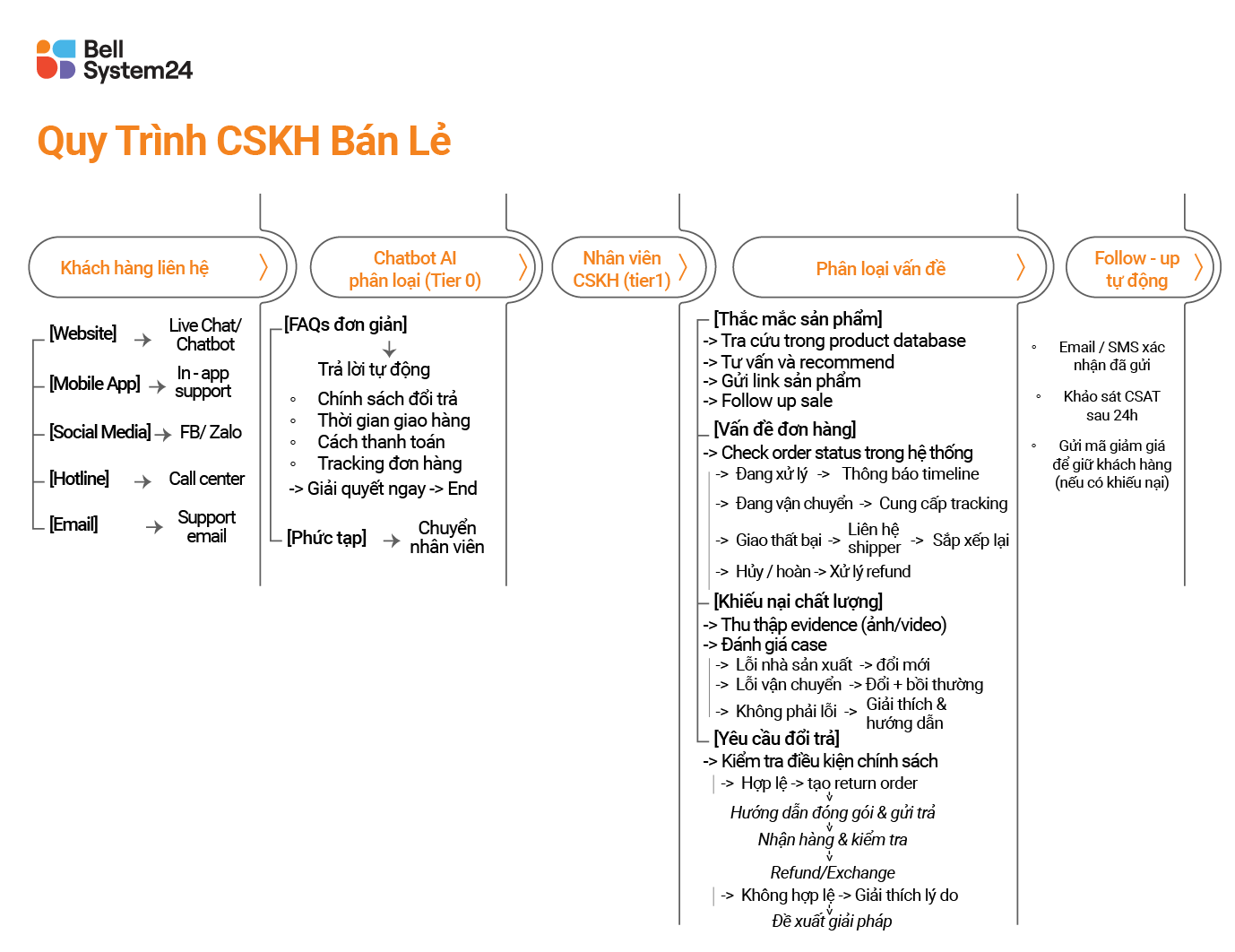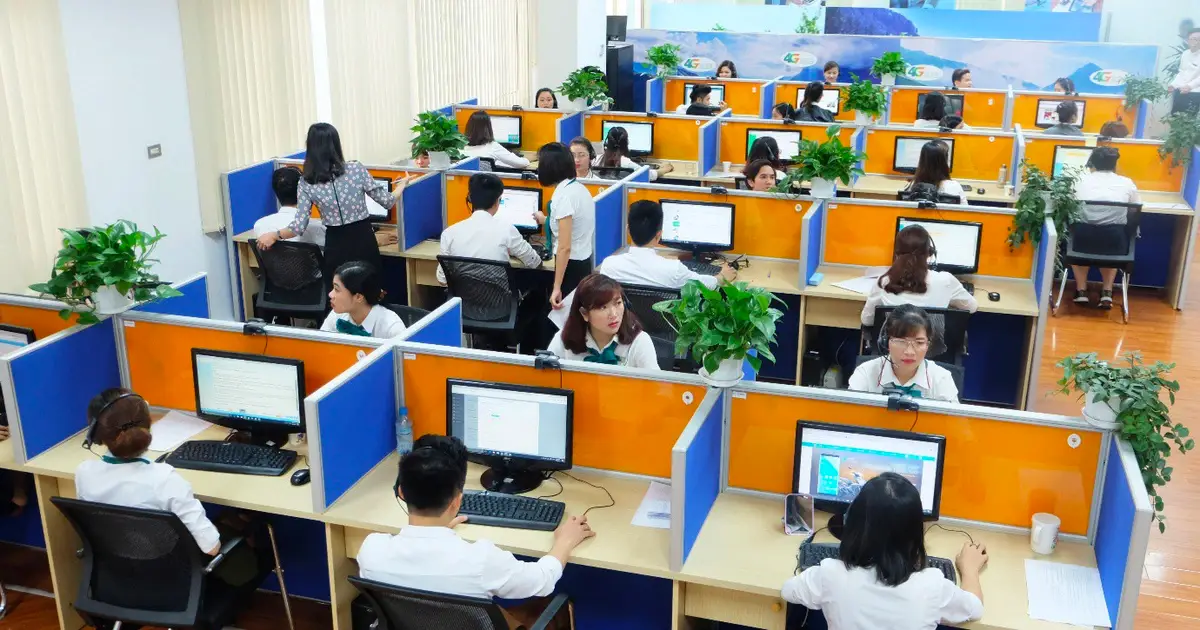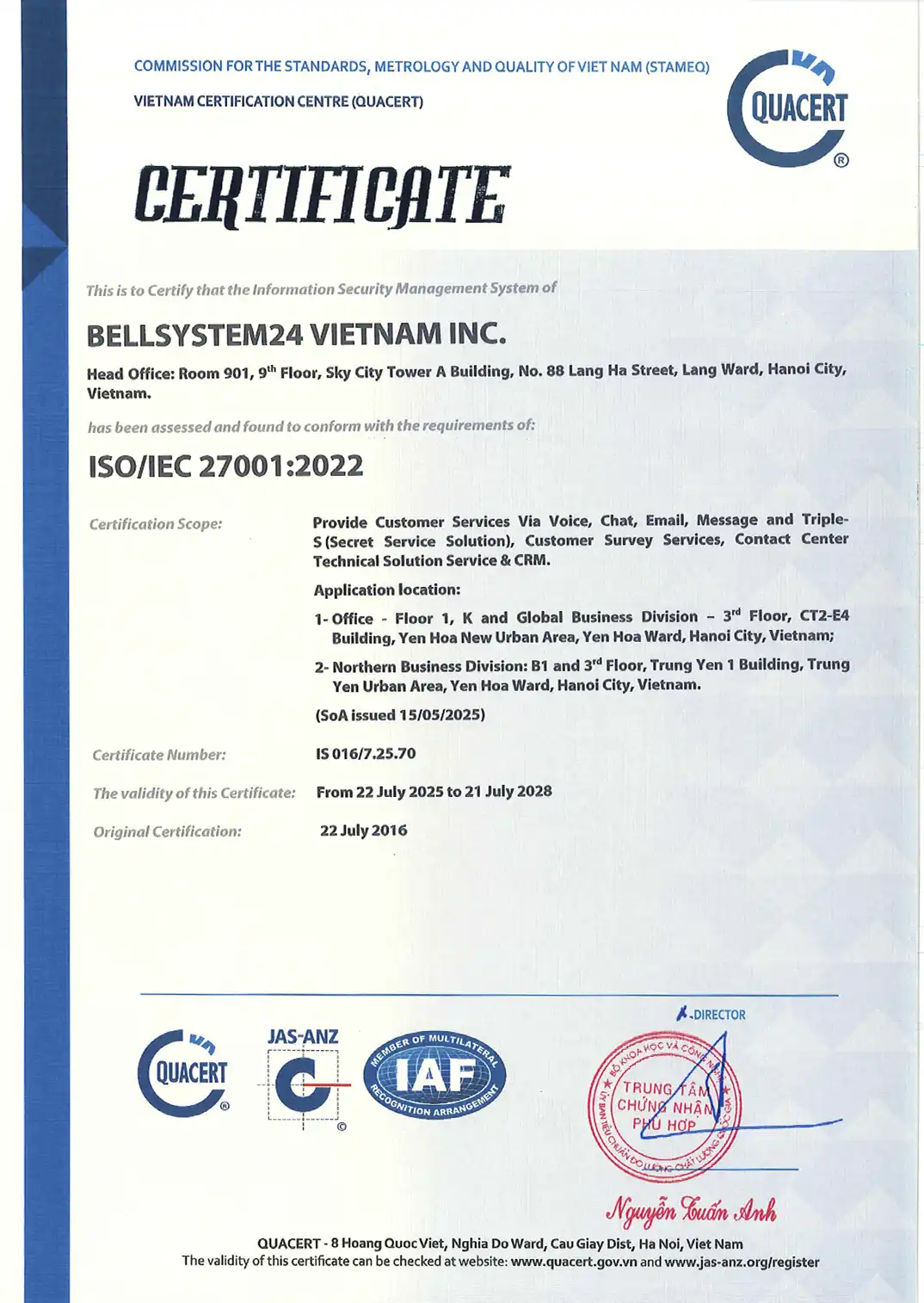Service level agreement in the business call center
In a call center environment, a Service Level Agreement (SLA) is understood as a commitment between the service provider and the customer regarding specific performance standards. SLAs include quantitative targets, such as response time, successful call answer rate, and first contact resolution (FCR) rate. These are not only tools for evaluating effectiveness but also the foundation for building trust between customers and providers.
In fact, the calculation Service Level Agreement It's quite simple, but many managers can still make mistakes when calculating. In this article, Bellsystem24 Vietnam will provide you with the formula, calculation method, and necessary notes when determining the service level agreement in a call center.

Service level agreement calculation formula
Calculating service level agreements is fairly simple but requires a high degree of accuracy to accurately reflect the operating status of the call center. The most common formula is:
l SL = (Number of calls answered within service level threshold / number of calls received) X 100
For example: NIf a business sets a target of answering 80% calls within 20 seconds, and within a given time frame, the call center answered 136 calls out of a total of 170 calls, then we have The following results:
- Number of calls answered within service threshold = 136.
- Number of calls received = 170.
- At this time the service level is: SL = (136/170) X 100 = 80%.
(To get the above figures, you can perform extract data in ACD from the call center or may collect data from detailed call records (CDR)
Service level calculation must be done continuously, and according to a certain time frame, usually call centers will calculate service level every 30 minutes. Because Each different time point will have different indexes, Service level at 8:30 am will be different from 8:30 pm (20:30 minutes).
By defining service levels at different time points, you will calculate the number of staff needed for each operating hour.
We have an article on this issue, you can see it here: How to calculate the number of staff for Call center.
Do you need to comply with Call center industry standards?
As you know, the standard Service level in the Call center industry is 80/20, which means that 80% calls received will be answered within the first 20 seconds.
Currently, this is also the standard used by many businesses. However, you can change the Service level standard to match your expectations. customer experience and the resources you have.
Many businesses want to upgrade SL to 90/10 threshold to improve customer experience and increase operational efficiency, but to do this requires that your operating processes and the quality of your staff are really good and optimal.
! Note that: SL reaching 100% will never happen. We have a customer care case study for our partner to achieve SL up to 99/20, you can refer to it here: Case study achieving a Service Level of 99.11% for Bellsystem24 Vietnam.
You can see the correlation between wait time and customer satisfaction survey in the table below.

Important considerations when calculating service level agreements
1. The impact of wait time on service level agreements
Waiting time is the deciding factor. customer satisfaction level and directly impacts Service Level. According to research from Zendesk, 69% customers are willing to switch service providers if the wait time exceeds 1 minute. Therefore, optimizing response time not only helps improve service level agreements but also increases customer satisfaction.
For example, in a survey conducted at Bellsystem24 Vietnam, customer satisfaction dropped by 15% when wait times exceeded 30 seconds. This highlights the importance of maintaining wait times within the committed SLA threshold.
Continuity in each time frame: Service Level needs to be calculated according to specific time intervals, usually every 30 minutes. This helps accurately reflect demand and performance at different time frames, thereby supporting the optimization of human resources.
Handling calls under 5 seconds: Calls with a wait time under 5 seconds, usually due to customers dialing the wrong number, should be excluded to avoid affecting the accuracy of the Service Level. The modified formula could be:
2. Should calls with a waiting time of less than 5 seconds be counted?
The appearance of calls with short waiting times of less than 5 seconds may be due to the user dialing the wrong number and then hanging up immediately.
5S
You can limit the number of calls agents have to answer to users who dial the wrong number by setting up call routing with ACD, avoiding wasting agent time.
You can also calculate service level for this case.
lSL = [Number of calls answered within service level threshold / (Number of calls received – Number of calls under 5 seconds) X 100]
3. Notes when reading the ACD data table
On some ACD systems, the service level display can be misleading to many managers.
For example, you have a SL standard of 80/20, which means 80% calls must be answered within the first 20 seconds. When you set this default formula, many ACDs will display 100%, this does not mean that 100% calls you received were answered within 20 seconds. It means that 100% of the 80% calls were answered within the 20 second response standard you set at the beginning.
Similarly, if the statistic is 80%, it means that only 64% of 80% were answered within the 20 second threshold.
! This has caused misunderstandings for many managers, you need to take note!
4. Fraud in calculating service level agreements when outsourcing call centers
This section is for businesses that are currently implementing or intend to implement outsourced call center from another supplier. Many cases of manipulation Key performance indicators in call center operations may occur, significantly affecting the accurate assessment, especially for the lessee.
When outsourcing Call center, both parties will have SLA agreement (Service level agreement: service level agreement), however, some untrustworthy suppliers can manipulate this index using the following tricks.
- Calculate SL but do not include unanswered calls.
- Temporary SL change.
- Create a manual call screening team: Create a team of agents who specialize in classifying calls (similar to ACD but done by humans) and record the response time of this classification team to calculate the service level.
How to improve the index Service Level Agreement
To improve Service Level AgreementFirst, optimize schedules and staffing by using automated scheduling tools (Workforce Management – WFM) to efficiently allocate personnel according to each time slot. For example, a contact center with a target SLA of 80/20 (80% of calls answered within 20 seconds) increased its score from 70/30 to 82/18 after adding 20% more staff during peak hours.
Second, apply automation technologies such as interactive voice response (IVR) systems, chatbots, or artificial intelligence (AI) to handle simple requests, reducing the workload for employees. Specifically:
- Interactive Voice Response (IVR) System: IVR helps classify requests as soon as customers contact us, transferring simple calls such as bill inquiries and appointment checks to the automated system.
- Chatbots and virtual assistants: Deploy intelligent chatbots to handle common questions, reducing the workload for call center agents.
Third, reduce the abandonment rate by providing a callback option when the queue is overloaded. An insurance company that implemented the callback feature when the wait time exceeded 3 minutes reduced the abandonment rate from 12% to 5% and increased the SLA from 78% to 85%.
Finally, flexible monitoring and adjustment using real-time analytics tools can maintain SLAs even in unexpected situations. For example, an international contact center maintained an SLA of 88% during a promotional campaign by quickly adding staff when call volume surged.
Overall, optimizing schedules, applying technology, reducing dropout rates, improving employee skills, and real-time monitoring are effective solutions to improve Service Level Agreements. These measures not only enhance the customer experience but also increase operational efficiency, transforming SLAs from a measurement metric into a foundation for building customer trust and loyalty.
Tell us about your Service Level Agreement goals with Bellsystem24 Vietnam.
Connect with us and talk about the service level metrics you want to achieve to improve the quality of your customer journey. We'll help you make it happen.







